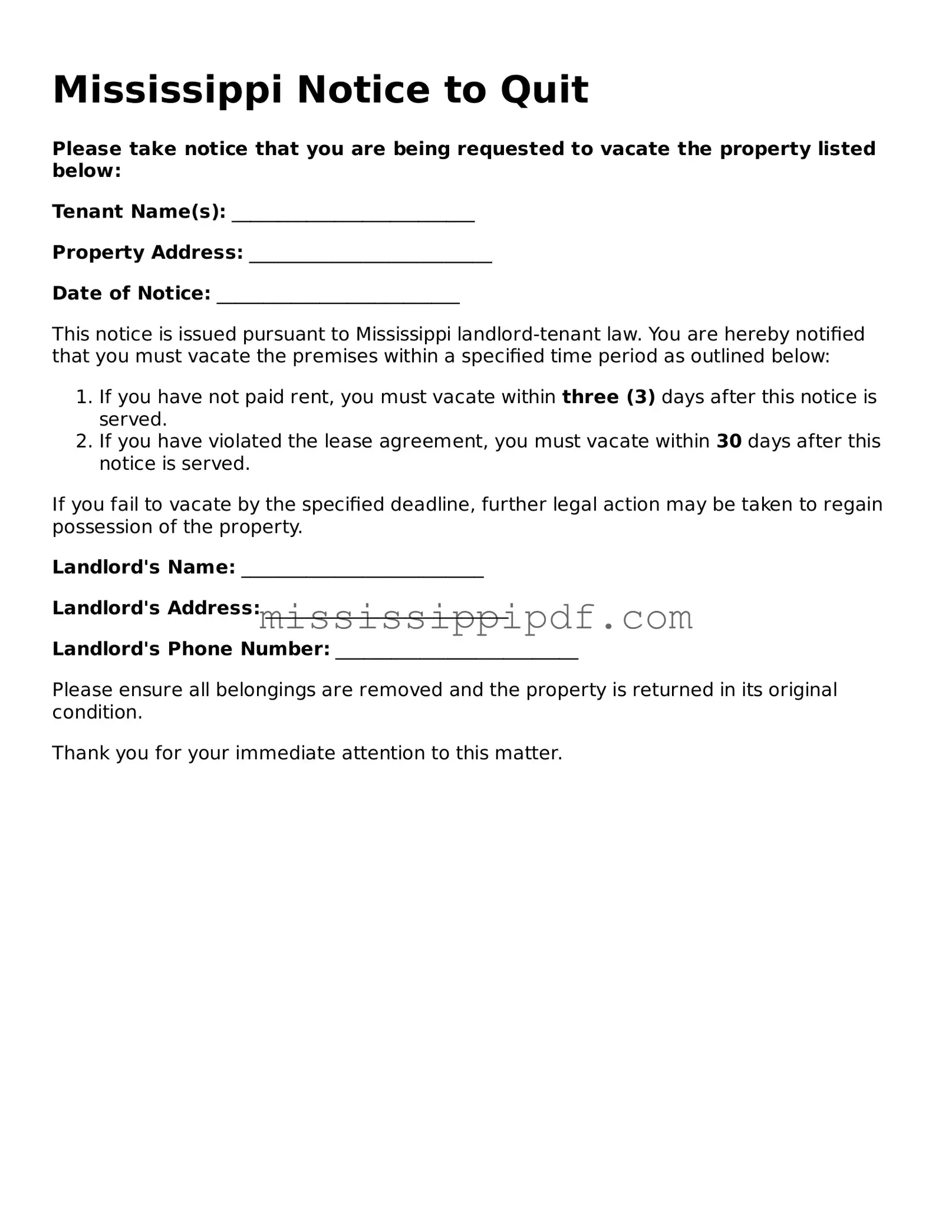The Eviction Notice is a document that landlords use to inform tenants of the intention to terminate their lease. Similar to the Mississippi Notice to Quit, it specifies the reasons for eviction, such as non-payment of rent or lease violations. This document outlines the time frame within which the tenant must vacate the property, ensuring that both parties are aware of their rights and obligations. The Eviction Notice serves as a formal communication that can lead to further legal action if the tenant does not comply.
A Lease Termination Letter is another document that shares similarities with the Mississippi Notice to Quit. This letter is typically used by landlords or tenants to end a rental agreement. Like the Notice to Quit, it must be delivered within a specific time frame, depending on the lease terms and state laws. The Lease Termination Letter clearly states the effective date of termination and any required actions, such as returning keys or settling outstanding rent, making it a crucial part of the rental process.
The 3-Day Notice to Pay Rent or Quit is a specific type of eviction notice used in some states, including Mississippi. This document demands that tenants pay overdue rent within three days or vacate the premises. Like the Notice to Quit, it serves as a formal warning and establishes a timeline for the tenant's response. The urgency of this notice is designed to prompt immediate action from the tenant regarding their financial obligations.
The 30-Day Notice to Vacate is a common document used by landlords to inform tenants that they must move out within 30 days. This notice is similar to the Mississippi Notice to Quit in that it provides clear communication regarding the end of the tenancy. It is often used in month-to-month rental agreements and allows tenants sufficient time to find alternative housing, thus promoting a smoother transition for both parties.
To ensure clarity and protection in financial transactions, a legally binding agreement is essential, such as the Minnesota Promissory Note. This document serves as a written promise to pay a specified amount of money at a future date, outlining important terms like interest rates and payment schedules. For those ready to proceed, you can find the necessary information and begin this process by accessing the Promissory Note form.
The 14-Day Notice to Cure or Quit is another document that resembles the Mississippi Notice to Quit. This notice is specifically used when a tenant has violated lease terms, providing them with a two-week period to correct the issue. If the tenant fails to comply, the landlord can then initiate eviction proceedings. This notice balances the need for enforcement with the tenant's right to remedy their situation.
The Notice of Non-Renewal is issued by landlords to inform tenants that their lease will not be renewed. Similar to the Mississippi Notice to Quit, it provides a clear timeline for the tenant to vacate the property. This document is particularly important for fixed-term leases, as it helps both parties plan for the end of the rental agreement and avoid misunderstandings.
The Rent Demand Letter is a document that landlords use to formally request overdue rent from tenants. This letter is akin to the Mississippi Notice to Quit in that it serves as a warning before taking further action. It outlines the amount due and the consequences of failing to pay, which may include eviction. The Rent Demand Letter emphasizes the importance of timely rent payments and helps maintain clear communication between landlords and tenants.
The Notice of Default is a document typically used in mortgage situations but shares similarities with the Mississippi Notice to Quit in terms of notifying individuals of a breach of agreement. This notice informs the borrower that they have defaulted on their mortgage payments and provides a timeframe to rectify the situation. While it pertains to property ownership rather than rental agreements, both documents aim to resolve issues before escalating to legal action.
